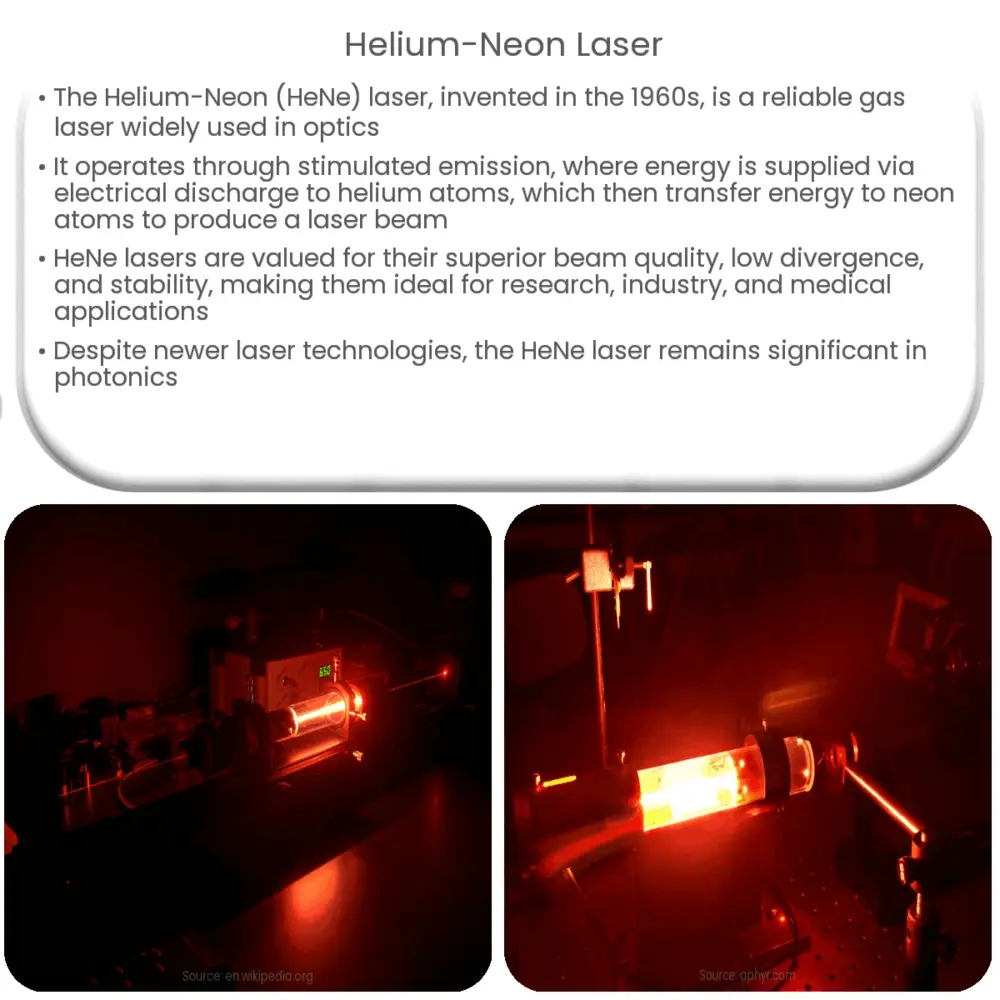Explore the fundamentals, structure, features, applications, pros & cons, and future of Helium-Neon lasers in our comprehensive guide.

Introduction to Helium-Neon Lasers
The Helium-Neon (HeNe) laser is a type of gas laser known for its simplicity, robustness, and reliability. First invented in the early 1960s, the HeNe laser has since been a staple in scientific laboratories and educational institutions around the world, serving as a fundamental tool in the field of optics.
Principle of Operation
A HeNe laser operates on the basic principle of stimulated emission of radiation. This process involves two primary steps: pumping energy into the system and subsequently releasing that energy in a coherent light beam. The energy is initially supplied to the helium-neon gas mixture in the form of electrical discharge, which excites the helium atoms.
- The excited helium atoms collide with neon atoms, transferring their energy.
- The neon atoms, now in an excited state, emit photons when they return to their ground state.
- These photons stimulate other excited neon atoms to emit more photons of the same wavelength, direction, and phase, leading to a coherent light beam – the laser beam.
Structure of a HeNe Laser
A typical HeNe laser is composed of several fundamental components:
- Laser Tube: This is a sealed glass tube that contains the helium-neon gas mixture. The proportion of the gases is typically around 10:1 helium to neon.
- Electrodes: Positioned at either end of the laser tube, these supply the electrical discharge needed to excite the helium atoms.
- Optical Resonator: Comprising a pair of mirrors placed at both ends of the tube, the optical resonator directs and amplifies the laser beam. One mirror is fully reflective, while the other is partially reflective to allow the laser beam to exit.
Key Features of HeNe Lasers
HeNe lasers are renowned for their excellent beam quality and very low divergence, making them ideal for interferometry, holography, and barcode scanning. The most common HeNe lasers emit a red beam with a wavelength of 632.8 nm, but they can also be designed to emit at other wavelengths, ranging from the infrared to the green regions of the light spectrum.
Furthermore, HeNe lasers are known for their long coherence length and stable output power, which are crucial for many experimental and industrial applications. Despite the advent of newer laser technologies, the HeNe laser remains a reliable and invaluable tool in the world of photonics.
Applications of HeNe Lasers
Over the years, the versatility of HeNe lasers has enabled their use across various domains:
- Scientific Research: In labs, HeNe lasers are commonly used for interferometry, holography, and spectroscopy. Their long coherence length and stable output power make them ideal for these applications.
- Industry: HeNe lasers are used in industrial applications such as alignment, positioning, and barcode scanning.
- Medicine: HeNe lasers also find applications in medical fields, including phototherapy and skin treatments.
Advantages and Disadvantages
Like all technologies, HeNe lasers have their strengths and weaknesses:
- Advantages: HeNe lasers offer several benefits, including excellent beam quality, low beam divergence, long coherence length, and stable output power. Additionally, their design simplicity and robustness contribute to their longevity and low maintenance needs.
- Disadvantages: On the downside, HeNe lasers have relatively low efficiency, typically around 0.1%. They also require high voltage for operation and have a higher cost per unit of output power compared to diode lasers.
Future of HeNe Lasers
While the advent of semiconductor lasers, especially diode lasers, has led to a decline in the use of HeNe lasers in some applications due to higher efficiency and lower costs, HeNe lasers continue to hold their ground in applications where beam quality and coherence are paramount.
Conclusion
In conclusion, the Helium-Neon laser, with its distinctive red beam, has made significant contributions to the fields of science, industry, and medicine. Despite certain limitations, its exceptional beam quality, coherence, and stability make it an invaluable tool in numerous applications. While newer laser technologies continue to evolve, the HeNe laser’s distinctive place in the world of photonics remains secure, underlining its enduring relevance and importance.

